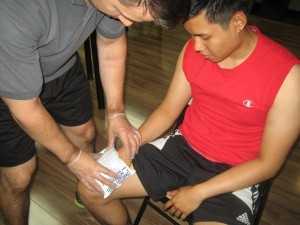
When sufficient force is applied to wrist, it can cause any one of the wrists to break. The radius is the most commonly broken bone in the wrist. Among the wrist bones, the scaphoid is the most commonly fractured bone.Wrist fractures often occur after falls, as the natural tendency is to stretch out a hand when the fall occurs. It usually takes four to six weeks for complete healing in adults. Kids generally have a shorter recovery period.
Types of Wrist Fracture
There are different types of fractures that involved the wrist. Some of the more common types include:
- Colles’ fracture
- Fracture through the distal metaphysis of the radius
- Smith’s fracture
- Reverse of Colles’ fracture
- Garden spade deformity
- Barton’s fracture
- A Colles’ or Smith’s fracture with dislocation
- Scaphoid fracture
- Easily missed
- Chaffeur’s fracture
- Greenstick fracture
- Common in children
- Ulnar Styloid Process fracture
Causes of Wrist Fracture
The following are the most common causes of wrist fractures:
- Falling onto an outstretched hand
- Motor vehicular accidents
- Sports injuries, especially in skating, snowboarding and gymnastics
Symptoms ofWrist Fracture
It may sometimes be hard to tell when one of the small bones of the wrist is broken as they do not typically cause deformities. However, one of more of the following symptoms may be present, which could indicate a wrist fracture:
- A snap or pop felt/ heard at the time of the injury
- Pain that increases with movement or pressure and tenderness, especially when touched
- Swelling and bruising, which usually appears within 30 minutes of injury
- Difficulty moving the wrist or inability to move the wrist at all
- Weakness in the forearm or hand
- Cool, pale or cyanosis of the arm or hand
- Reduced pulse or no pulse detected
- Numbness or coldness
- Deformity, depending on the affected bone
First Aid Management for Wrist Fracture
Recovery time for a wrist fracture will depend on a person’s age and health, and type and severity of fracture. If the wrist fracture is severe, call for emergency assistance. However, applying first aid as soon as the fracture occurs can help reduce risks for complication. To give first aid, the following steps can be followed:
- If there is an open wound, apply direct pressure to the bleeding area using a sterile absorbent cloth. Raise the affected arm above heart level, if possible.
- Place an ice pack for 20 minutes to the swollen area to reduce swelling. Do this four to eight times during the first day. Do not apply ice directly to the skin.
- Immobilize the fractured wrist. If one is trained to apply a splint, create a makeshift splint, such as a pillow or sling. Minimize wrist motion to avoid further injury.
- Do not attempt to move the bone to its original position as it may just lead to damages. If the bone is protruding, do not attempt to push back.
Disclaimer: This article is for information purposes only and not meant to substitute for medical advice or first aid training. To learn how to treat and manage wrist fractures and other broken bones in the body, register to join in First Aid Training.